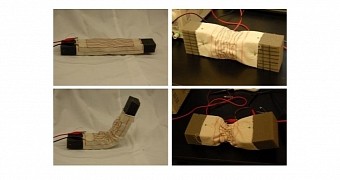Despite all the science-fiction drama surrounding robots, be they humanoid or of some other sort, there is no way that the scientific community will stop their development anytime soon. It still leaves room for some surprises though.
You may or may not have noticed that humanoid bots have been catching a bit of ribbing because they still can't really walk properly, for the most part.
Automatons used in manufacturing, as well as walkers of various types intended for military deployments, have been seeing a lot of attention too.
Now, though, soft robotics are beginning to cause ripples. Sometimes it's literally, as the Octopus Bot showed the other day, although, admittedly, the ripples aren't exactly visible once the robot has been fully submerged.
Now, another type of soft robot, or rather soft robotic component, has come to light: a robotic fabric that can change shape and rigidity depending on temperature.
Robotic fabric enables creation of active clothing
We've been going on about wearable technology for many months at this point. But while headphones, eyewear, and smartwatches have all been running around, high-tech clothing is still underrepresented.
Now, though, researchers at Purdue University have developed a robotic fabric that might allow shirts, pants, and shoes to assume a behavior, after a fashion.
Then again, electronic clothing isn't what the research team was thinking about then they developed the robotic fabric. Or the beginnings of one.
Instead, they set out on their quest with the ultimate goal of enabling the creation of soft robots, whose main bodies would be made of foam or other lightweight substances.
The fabric itself is primarily composed of a flexible polymer. This polymer can contract and relax depending on temperature, since shape and rigidity change when heated.
The team tested the properties of the fabric by wrapping it around a piece of foam. They were able to make the whole thing bend, move in specific ways, even wriggle. It would probably look really disturbing in the dark.
Practical applications
Space missions are one option, since the fabric could help build exploration robots at low cost. There are many lightweight and cheap materials that could be easily transported into space and that would gain self-locomotion thanks to the new cloth. Basically, anything can be a robot, because the fabric/skin has all the necessary technology (vibration-resistant flexible circuits, mostly). Strength-enhancing clothing and medical braces are being bandied about as well, among other things.

 14 DAY TRIAL //
14 DAY TRIAL //